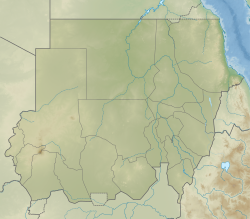| Location | Sudan |
|---|---|
| Coordinates | 16°40′12″N 33°26′59″E / 16.67°N 33.4496°E |
| History | |
| Associated with | Central Sudanese Neolithic |
| Site notes | |
| Archaeologists | Francis Geus with the SFDAS |
Grinding stones
editGhaba excavations revealed grinding stones and sandstone grinders. These types of tools are characteristic of grinding cereals, but may have been used for other things like polishers for tools.
Palettes
editPalettes are common grave goods in Neolithic Sudan. At Ghaba they were mostly made of granite and sandstone, and the shapes were not very uniform. They feature a smooth concave side, and a rougher convex bottom. The smooth side often had traces of red ochre.
Bone Tools
editA number of Bovine bone fragments were found at Ghaba. Bone tools were characteristic of Neolithic Sudan and not unique to this site. Because of the very poor preservation of bone in general, very little can be interpreted from these, though a few specific tools have been identified. These include a perforator, a comb, and spatulas. Bone tools were likely used for many other things not preserved or not recorded in the funerary context.
Dental analysis
edit1.7% of individuals had dental caries, indicating a mostly non agricultural diet, and low carb intake, despite evidence for agriculture in the form of the white powder in some graves. 1.7% of individuals also showed enamel hypoplasia, which is an indicator of chronic childhood stress, meaning the severe stress was uncommon at Ghaba. These dental patterns show the people at Ghaba had good dental health, which may further be indicative of overall good health.
Analysis of dental traits at many Neolithic Sudanese sites shows Ghaba fits in particularly well with upper Nubian dentition like in Al Khiday. This indicates a biological origin in Upper Nubia, most likely with Mesolithic Al Khiday.
